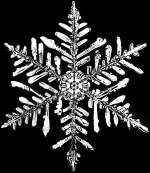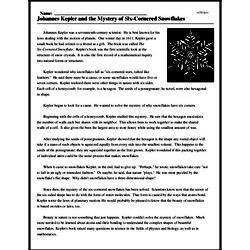Johannes Kepler and the Mystery of Six-Cornered Snowflakes
Johannes Kepler was a seventeenth-century scientist. He is best known for his laws dealing with the motion of planets. One winter day in 1611, Kepler gave a small book he had written to a friend as a gift. The book was called The Six-Cornered Snowflake. Kepler's book was the first scientific look at the structure of snow crystals. It is also the first record of a mathematical inquiry into natural forms or structures.
Kepler wondered why snowflakes fall as "six-cornered stars, tufted like feathers." He said there must be a cause, or some snowflakes would have five or seven corners. Kepler realized there were other things in nature with six sides. Each cell of a honeycomb, for example, is a hexagon. The seeds of a pomegranate, he noted, were also hexagonal in shape.
Kepler began to look for a cause. He wanted to solve the mystery of why snowflakes have six corners.




